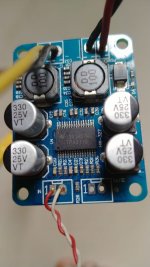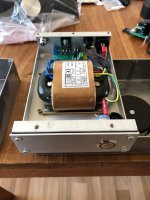Try some kind of simple battery, like 12V, instead of your other supplies. Use a fuse inline. 1A is enough. If it blows from the battery your amps are done. Some DC supplies, like for LED do put out some kind of pulsed voltage and amps don't like this.
Can you measure the resistance of the boards DC input?
Can you measure the resistance of the boards DC input?
I don't have branding on the back side of the PCB, otherwise same stuff
Attachments
Yep, 32 pins that is OK. It helps to use Molex for signal and Phoenix connectors for power/loudspeaker on those boards as PCB tracks peel off very fast when mechanical force is applied (which happens with wires soldered to boards directly). Shielded wiring for the input is also a good way to have them performing OK. The usual mods with reducing gain (can't read the values) and removing the diode still apply.
Be very careful and work fast and tidy as the board material is throw away quality, at least with the ones I have. There is not much of a second chance you see. The gain mod (if necessary, you can read the values) brings most, the diode mod less.
Be very careful and work fast and tidy as the board material is throw away quality, at least with the ones I have. There is not much of a second chance you see. The gain mod (if necessary, you can read the values) brings most, the diode mod less.
Last edited:
Excellent suggestion. These are just temporary arrangements for testing. I will implement your tips it in my final iterationIt helps to use Molex or Phoenix connectors on those boards as PCB tracks peel off very fast when mechanical force is applied (which happens with wires soldered to boards directly). Shielded wiring for the input is also a good way to have them performing OK.
I encased 2 of these with a 14V linear LDO PSU in a very small casing together with a transformer and it surprised many that listened to it. Please use standoffs and a metal casing if quality is the goal. Don't worry about heat but do have some ventilation slots and measure temp to be sure.
Can you please describe how you made 14V LDO PSU & what is its max Amperage?. I'm just using it with laptop brick and can hear faint noises from tweeter. Plus it cuts off audio intermittently with difficult 4Ohms load. With 8Ohms , its pretty good and cheerful. Metal casing and vents? I learned that the hard way , initially I had assembled it in an salvaged old modem plastic box. For other remaining boards, I have got metal cases.
Mmm, I am not sure if my heretical approach with linear PSUs will be appreciated. Yes many SMPS (disclaimer: which are the very best for audio as we know) exhibit extra features so you'll always have some signal heard 🙂 I used one of my own LT1764 PSUs that can deliver a meagre 3A and a 4A R-core transformer. This is not much but I play at low volume and get away with that. It was only because of the TPA3118 hype then so I thought it was justified as many of those amplifiers end up as Schubladenverstärker. As I found a full rail of LT1084 I would use those now. The gerbers of Aleš Mravlak are perfect for this.
https://www.diyaudio.com/community/threads/linear-regulator-pcb-lm317-lt1085-lm338-lt1083.254981/
BTW bridging the input caps with 2.5 mm film caps Wima 100 nF is a nice improvement. Keep lead wires as short as possible.
https://www.diyaudio.com/community/threads/linear-regulator-pcb-lm317-lt1085-lm338-lt1083.254981/
BTW bridging the input caps with 2.5 mm film caps Wima 100 nF is a nice improvement. Keep lead wires as short as possible.
Last edited:
An unfinished/superfluous external 35...40VA example with the Aleš Mravlak board. Maybe good for inspiration. Build linear LDO, be happy. Nice to do and easier than many DIY endeavours. I built several of these and noise is quite low. The jack plug and cable of the SMPS it replaces can be cut off and reused.
Attachments
Last edited:
That transformer is a piece of art! Very good isolation.An unfinished/superfluous external 35...40VA example with the Aleš Mravlak board. Maybe good for inspiration. Build linear LDO, be happy. Nice to do and easier than many DIY endeavours. I built several of these and noise is quite low. The jack plug and cable of the SMPS it replaces can be cut off and reused.
"bridging the input caps with 2.5 mm film caps Wima 100 nF is a nice improvement" ,- By bridging , you mean soldering in parallel?
Attachments
Yes. Both of them. It helps to glue 2 of them together and after the glue has hardened to bend the pins so stuff fits. Then solder.
The transformer is such an example of having good quality for a good price.
The transformer is such an example of having good quality for a good price.
I have heard of many cases where a nice linear supply made a Class D amp sound better. Nice work.An unfinished/superfluous external 35...40VA example with the Aleš Mravlak board. Maybe good for inspiration. Build linear LDO, be happy. Nice to do and easier than many DIY endeavours. I built several of these and noise is quite low. The jack plug and cable of the SMPS it replaces can be cut off and reused.
For some extra cash you can have linear psu with these 3000 euro speakers too. Look at the pcb 🙂
https://6moons.com/audioreview_articles/ancient-audio-vintage-horten/
https://6moons.com/audioreview_articles/ancient-audio-vintage-horten/
Maybe I'm talking garbage, but did you each the heat transfer grease between the amp chip and the heatsink?Can you please describe how you made 14V LDO PSU & what is its max Amperage?. I'm just using it with laptop brick and can hear faint noises from tweeter. Plus it cuts off audio intermittently with difficult 4Ohms load. With 8Ohms , its pretty good and cheerful. Metal casing and vents? I learned that the hard way , initially I had assembled it in an salvaged old modem plastic box. For other remaining boards, I have got metal cases.
I had a similar cut-off at high levels, and then checked the heatsink. The grease was dry! Used that silver stuff prom PCs and never again any audio cuts.
Explanation, please. Could somebody explain in simple terms what that "mute" part of the board is for? (Elimination of turn on thumps?)
And - how to wire / make the connections.
Thanks,
MW
And - how to wire / make the connections.
Thanks,
MW
The interesting pic is at the top of page 3 of this review : https://6moons.com/audioreview_articles/ancient-audio-vintage-horten/3/Look at the pcb 🙂
when the mute pins are shorted with a switch (closed) - no sound or muteExplanation, please. Could somebody explain in simple terms what that "mute" part of the board is for? (Elimination of turn on thumps?)
And - how to wire / make the connections.
Thanks,
MW
Open or left as it is - sound or unmute
Do you refer to the 4$ amp boards inside an very expensive speaker? 6moons is not a review site, but promotion for expensive stuff made for lunatic's.The interesting pic is at the top of page 3 of this review : https://6moons.com/audioreview_articles/ancient-audio-vintage-horten/3/
IMO it is a waste of time to read the long articles that contain no substance at all. Just look for Boenicke or LessLoss firewall to name a few. Snake oil dripping out of every corner. By the way: Corner. Did you ever improve an amp by rounding the corners of the PCB? We all missed this important part!
- Home
- Amplifiers
- Class D
- Cheap TPA3118D2 boards, modding them and everything that comes with it



